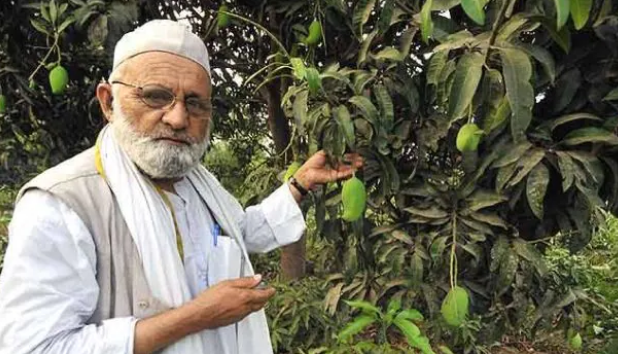
Kalimullah Khan, age 80, known as the “Mango Man,”of India has created a magical mango tree that grows more than 300 varieties. Its huge canopy, which stands tall in a nursery near Lucknow, Uttar Pradesh's capital, is wide enough to seat 15 people for a picnic, and its branches are laden with fruit.
Each branch's leaves have a different texture: Others are shiny and bright, while others are dull green or olive green. The mangoes on each branch are also unique, being rectangular, oval, or kidney-shaped, and varying in color from green to yellow to brown, pink, and purple.
Khan's mango farm is located in Malihabad, a vast mango belt and mango lover's delight in Northern India, with over 10,000 hectares equivalent to around 40 square miles of mango farms. Also, India continues to be the world's largest producer of mangoes, with over 1,000 varieties grown and accounting for more than 40% of global production.
Khan tends to cultivate 22 acres of farmland that his grandfather cultivated in the early 1900s, with the aid of his son. Khan dropped out of high school to pursue this as a career, and his family produced only a few local varieties, similar to nearby mango farms. When Khan was 15, he saw crossbred roses in a friend's backyard, with one rose plant producing flowers in various colors, the seeds of his fascination with mango grafting were sown. It made him wonder if different types of fruits could be produced by the same tree.
When he was 17, he grafted seven different mango varieties onto a single tree. When floods destroyed the oak, he was absolutely devastated, but he was eager to learn more about grafting, which he had learnt about on his family's orchards. Khan perfected the technique of cutting a branch from one tree, chopping notched angles into it, and then adding the orphaned cutting to a new, hybrid tree over time. He began grafting cuttings of various varieties onto a 100-year-old mango tree in 1987. He gathered samples from all over the world, looking for unusual varieties. According to Khan, the tree now produces more than 300 different mango varieties. It's known as Al Muquaraar, or The Resolute, by him.
“This wonder tree isn't just a tree; it's a whole orchard, a universe,” Khan says. I inquire as to how Khan keeps the tree safe from birds and insects. He says, "I don't scare them away." “Nature's bounty is meant to be shared.” During harvest season, Khan and his son load the farm's produce in crates to market and export, but they give the miracle tree's fruits away for free to tourists who come to see it.
He not only grafts, but also breeds new mango hybrids, experimenting with flavor and texture, as well as giving them unusual names. He has sent new mangoes the names Narendra Modi (Namo Aam) and Bollywood actress Aishwarya Rai Bachchan. “I named it after famous cricketer Sachin Tendulkar, and he called to express his gratitude and happiness,” Khan says.
Khan has had superstar guests to the homestead and won various honors, including the Padma Shri, one of India's most noteworthy non military personnel grants, and records in the Limca Book of Records. He has visited Dubai and Iran to show the craft of grafting, and in 1999, he made a mango tree with in excess of 54 assortments for the Mughal Gardens joined to the Rastrapathi Bhavan, the official residence of the President of India.
The approval isn't all inclusive. "It's just craftsmanship and of no business esteem," says D.K. Sharma, the Vice President of the Mango Grower Association of India, who reprimands Khan's masterpiece as restorative and not profiting cultivators. Khan deviates, bringing up that grafting is unimaginably normal in the business creation of leafy foods, since ranchers and producers need consistency as opposed to the inconstancy of developing from seed. He considers it to be a craftsmanship with functional worth.
"I need to live on even after my demise, through the mangoes I have developed. I trust that individuals will eat my rewards for so much hard work and advantage somehow or another," says Khan. "That is the magnificence of nature. It continues giving."












